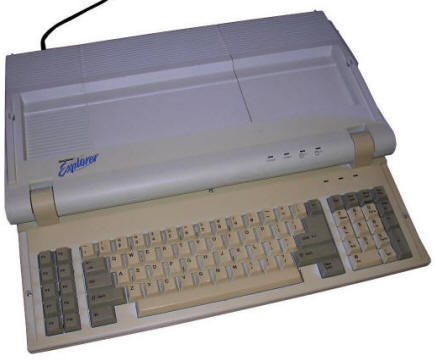Vendex HeadStart Explorer
In 1980s most computer companies started to sell small
PC-compatible systems as "starting points" for new PC users and as
PC-compatible home computers. In 1989, Vendex company from Nederlands
who already made electronic products and DIY kits released a HeadStart
line computer called HeadStart Explorer. The trademark "HeadStart
Explorer" has been
registered in 1989 and the computer has been released shortly after.
It was probably designed by "CADAC" as this name is present on
mainboard's copper while "Explorer" is in silkscreen. The computer was
designed as a small home computer with limited expandability by the cost
of making the system smaller and all-in-one. The central processing unit
contains a keyboard on hinges, 3.5" floppy disk drive and in some
versions a 40MB hard disk named "AutoMagic". Display chip can show
graphics in CGA or Hercules-compatible modes. Full versions included a
proprietary mouse, monitor and a special monitor stand to easily put the
computer inside forming a comfortable workstation. But the most
characteristic part was the operating environment - 384kB of ROM
contained MS-DOS version 3.31 and Explorer GUI which allows to work in
PIM programs, database and text editor using mouse. The GUI is shown
using CGA mode and allows to launch DOS programs too.
The computer was produced in Korea while sold in USA and Nederlands. I
have information that some units have been bought in Poland too. Some
other units of the same "EX-938CP" model had no hard disk. In USA some
units have been sold under Magnavox brand.
| Manufacturer | Vendex | |
| Origin | Nederlands | |
| Year of unit | 1990? | |
| Year of introduction | 1989 | |
| Class | XT | |
| CPU | 8088 | |
| Speed | 4.77MHz , 9.54MHz | |
| RAM | 512kB | |
| ROM | Award BIOS MS-DOS 3.31 in ROM |
|
| Graphics | CGA/Hercules | |
| Sound | PC Speaker | |
| System expansion bus | 8-bit ISA (1 slot) | |
| Floppy/removable media drives | built-in 3.5" 720kB floppy disk drive | |
| Hard disk: |
40MB XTA Miniscribe 8450XT with proprietary edge connector. C/H/S: 805/4/26 |
|
|
Peripherals in collection: |
||
| Other boards:
|
None | |
| Non-standard expansions: | Unknown expansion slot near ISA bus (?Memory?) | |
| Operating system(s): | MS-DOS 3.31 in ROM with Explorer GUI |
I bought my unit from someone who found it in e-waste. In the hard disk, which is damaged and cannot be recovered because it has lots of bad sectors, I found few text files in Dutch, mostly with rock song lyrics, and some own creations from computer's owner, so I think the original owner was Dutch. Last files come from January 1994, first ones from 1990. What happened between computer left Nederlands and came to Polish e-waste is unknown.
| Contents: | Starting, usage | Configuration | Pinouts | Links |
Starting
The machine can start in two modes:
1. When no keys are pressed during boot-up, the unit starts to on-ROM
GUI which allows to work with calculator, text editor, database,
organizer and phone book as well as launching DOS applications from
disk. Hard disk appears as icon on desktop and clicking on it shows menu
with programs. The system may be configured to start right to the DOS
command prompt using control panel - the icon with computer. If you want
to go to DOS session, use the icon and press F3.
If you don't have mouse, use Alt+numpad arrow keys to move cursor and Alt+Enter to click.
2. If the ALT key is held at boot (right after keyboard is initialized) it will try to boot from floppy disk again and again (if hard disk is installed) or go to on-ROM DOS (if no hard disk is present).
The Miniscribe hard disk has on-firmware parking routine. Before turning the computer off just wait 10-20 seconds, the disk drive will emit a short high-pitched sound while the heads are transported into safe zone. Then the computer can be turned off. When testing, make sure that the fan built in hard disk casing works.
The machine has configuration in battery-backed ROM. Configuration can be made using on-ROM GUI tool (Computer icon). The only configuration on mainboard is the switch on the rear to switch between colour CGA and monochrome HGC display.
Mouse according to this forum post:

1 - X1
2 - SW1
3 - SW2
4 - GND
5 - X2
6 - Vcc
7 - Y1
8 - SW3
9 - Y2
Not tested, test at least Vcc/GND before using. Probably
mouse is phase-driven so my
universal mouse may work.
http://www.obsoletecomputermuseum.org/explode/ - In collection





